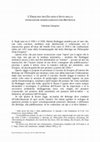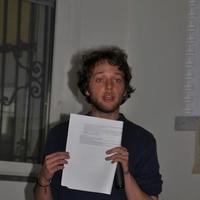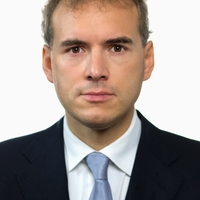Papers by Valentina Zampieri

La questione dell’Ereignis si presta ad essere interpretata come punto di continuità interna al e... more La questione dell’Ereignis si presta ad essere interpretata come punto di continuità interna al e nel pensiero della Kehre heiddegeriana. All’interno dei Beiträge zur Philosophie esso è il pensiero dell’altro inizio che prende le mosse da ciò che è rimasto impensato nel primo: l’aletheia greca. Il problema del fondamento si svolge come problema della relazione che intercorre tra Ereignis, Da-sein e Seyn. Tale relazione è equiparata da Heidegger ad un moto oscillatorio o pendolare, che mette in luce il bisogno e lo svoltarsi reciproco di Da-sein e Seyn. L’Ereignis si presenta come il disporre armonicamente ciò che così disposto viene ad esso appropriato e in sé stesso impropriato.
La questione della fondazione, per rendere manifesta questa triplice relazione primaria, chiama in causa la problematica dello spazio e del tempo mostrando come solo un fondo senza fondo (Ab-grund) è in grado di fondare autenticamente il darsi della verità dell’Essere che può essere accolta da un Da che solo si sappia appropriato all’Ereignis.
The concept of Ereignis (enowning) is apt to be detected as the thread running through the transformative turn (Kehre) that marks the passage between Heidegger’s Being and Time and Contributions (Beiträge zur Philosophie). In the latter work, Ereignis is thought as the “other beginning” whose starting point, i.e. alétheia, was concealed in the “first beginning”. Since the truth of be-ing is thought as enowing, the grounding question develops as such into the relation between enowning, be-ing and being-t/here. This is considered in turn as a rhythmical movement from side to side, a swaying that brings to light the mutual need and turning of being-t/here and be-ing. The enowning is a disposing movement in which what is disposed is also enowned to the Ereignis and established as its own property.
The grounding question entails the space-time problems in order to explain this triple relationship, since it shows that only an abysmal Ground, i.e. a groundless ground, is able to establish authentically the self-giving of the truth of be-ing, as it is really suitable for a t/here who knows its being enowned to and by the Ereignis.
Il problema dell’oggetto affrontato nell’analisi della Critica
della ragione pura di Kant condott... more Il problema dell’oggetto affrontato nell’analisi della Critica
della ragione pura di Kant condotta da Heidegger,
si snoda in diversi punti per offrire il modo corretto in
cui rapportarci all’oggetto stesso in una prospettiva fenomenologica.
Attraverso un’analisi metafisica è messa
in luce la domanda “che cos’è una cosa?” che si affianca
necessariamente alla domanda “che cos’è l’uomo?”.








Uploads
Papers by Valentina Zampieri
La questione della fondazione, per rendere manifesta questa triplice relazione primaria, chiama in causa la problematica dello spazio e del tempo mostrando come solo un fondo senza fondo (Ab-grund) è in grado di fondare autenticamente il darsi della verità dell’Essere che può essere accolta da un Da che solo si sappia appropriato all’Ereignis.
The concept of Ereignis (enowning) is apt to be detected as the thread running through the transformative turn (Kehre) that marks the passage between Heidegger’s Being and Time and Contributions (Beiträge zur Philosophie). In the latter work, Ereignis is thought as the “other beginning” whose starting point, i.e. alétheia, was concealed in the “first beginning”. Since the truth of be-ing is thought as enowing, the grounding question develops as such into the relation between enowning, be-ing and being-t/here. This is considered in turn as a rhythmical movement from side to side, a swaying that brings to light the mutual need and turning of being-t/here and be-ing. The enowning is a disposing movement in which what is disposed is also enowned to the Ereignis and established as its own property.
The grounding question entails the space-time problems in order to explain this triple relationship, since it shows that only an abysmal Ground, i.e. a groundless ground, is able to establish authentically the self-giving of the truth of be-ing, as it is really suitable for a t/here who knows its being enowned to and by the Ereignis.
della ragione pura di Kant condotta da Heidegger,
si snoda in diversi punti per offrire il modo corretto in
cui rapportarci all’oggetto stesso in una prospettiva fenomenologica.
Attraverso un’analisi metafisica è messa
in luce la domanda “che cos’è una cosa?” che si affianca
necessariamente alla domanda “che cos’è l’uomo?”.
La questione della fondazione, per rendere manifesta questa triplice relazione primaria, chiama in causa la problematica dello spazio e del tempo mostrando come solo un fondo senza fondo (Ab-grund) è in grado di fondare autenticamente il darsi della verità dell’Essere che può essere accolta da un Da che solo si sappia appropriato all’Ereignis.
The concept of Ereignis (enowning) is apt to be detected as the thread running through the transformative turn (Kehre) that marks the passage between Heidegger’s Being and Time and Contributions (Beiträge zur Philosophie). In the latter work, Ereignis is thought as the “other beginning” whose starting point, i.e. alétheia, was concealed in the “first beginning”. Since the truth of be-ing is thought as enowing, the grounding question develops as such into the relation between enowning, be-ing and being-t/here. This is considered in turn as a rhythmical movement from side to side, a swaying that brings to light the mutual need and turning of being-t/here and be-ing. The enowning is a disposing movement in which what is disposed is also enowned to the Ereignis and established as its own property.
The grounding question entails the space-time problems in order to explain this triple relationship, since it shows that only an abysmal Ground, i.e. a groundless ground, is able to establish authentically the self-giving of the truth of be-ing, as it is really suitable for a t/here who knows its being enowned to and by the Ereignis.
della ragione pura di Kant condotta da Heidegger,
si snoda in diversi punti per offrire il modo corretto in
cui rapportarci all’oggetto stesso in una prospettiva fenomenologica.
Attraverso un’analisi metafisica è messa
in luce la domanda “che cos’è una cosa?” che si affianca
necessariamente alla domanda “che cos’è l’uomo?”.